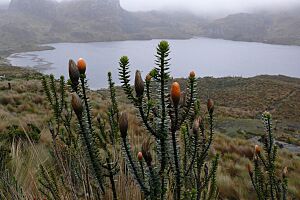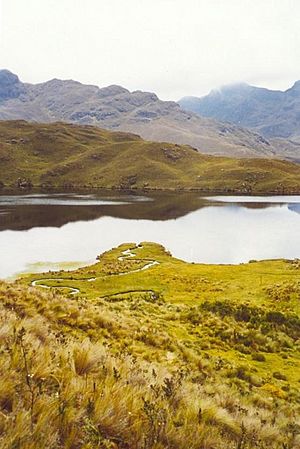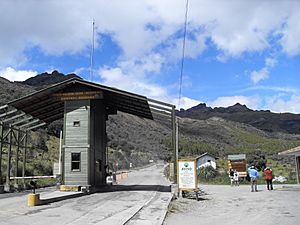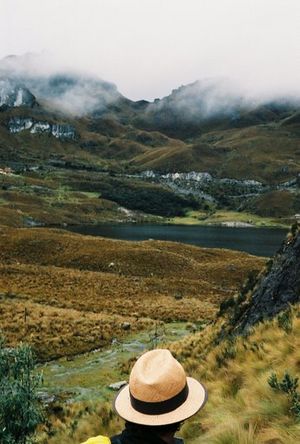El Cajas National Park facts for kids
Quick facts for kids El Cajas National Park |
|
|---|---|
|
IUCN Category II (National Park)
|
|

A lagoon in Cajas National Park
|
|
| Location | Ecuador Azuay Province |
| Nearest city | Cuenca |
| Area | 285.4 km2 (110.2 sq mi) |
| Established | November 5, 1996 (Resolution N° 057) |
| Official name: Parque Nacional Cajas | |
| Designated: | 14 August 2002 |
| Reference #: | 1203 |
El Cajas National Park, also called Cajas National Park (in Spanish, Parque Nacional El Cajas), is a special nature park in the mountains of Ecuador. It's about 30 kilometers (18 miles) west of Cuenca, a big city in the Azuay Province.
The park covers a huge area of 285.44 square kilometers (about 110 square miles). It sits very high up, between 3,100 meters (10,170 feet) and 4,450 meters (14,600 feet) above sea level. This high-altitude area is known for its unique landscape called páramo, which has many hills, valleys, and lakes. El Cajas became a National Park on November 5, 1996.
Contents
What Does "Cajas" Mean?
The name "Cajas" might come from the Quichua word "cassa," which means "gateway to the snowy mountains." It could also come from "caxa," meaning "cold." Some people think it's linked to the Spanish word "cajas," which means "boxes."
Mountains, Lakes, and Rivers
El Cajas National Park is a land of high peaks and many lakes.
- The tallest point is Cerro Arquitectos (Architects Hill), which is 4,450 meters (14,600 feet) high.
- Roads in the park can reach over 4,310 meters (13,550 feet) in elevation.
The park is famous for its many lakes.
- There are about 270 lakes and lagoons in the páramo area.
- Luspa is the biggest lake, covering 78 hectares (192 acres). It's 68 meters (223 feet) deep!
- All these lakes were formed by glaciation (when glaciers moved across the land). Glaciers also shaped the valleys, making them U-shaped.
El Cajas is super important because it provides about 60% of the drinking water for the city of Cuenca.
- Two of Cuenca's four rivers, the Tomebamba and Yanuncay rivers, start in Cajas. These rivers eventually flow into the mighty Amazon river.
- The Paute river also connects to the Amazon.
- On the western side of the park, the Balao and Cañar rivers flow towards the Pacific Ocean. This means the park sits on the continental divide, which separates rivers flowing to the Atlantic from those flowing to the Pacific.
The main road through the park crosses the continental divide at a spot called "Tres Cruces" (Three Crosses), which is 4,255 meters (13,960 feet) high. This is the westernmost part of the continental divide in South America.
Weather in El Cajas
The weather in El Cajas is cool, with an average temperature of about 13.2°C (55.8°F). It gets a lot of rain, about 1,072 millimeters (42 inches) each year. Clouds often come in from the Pacific coast and the Paute river basin, bringing lots of moisture.
Amazing Nature and Animals
The high altitude and humidity in El Cajas create a special environment. The soil holds a lot of water, which helps unique plants grow.
Plants of El Cajas
The main type of plant in the high grassland páramo is straw grass (Calamagrostis intermedia).
- There are 19 plant species that are found only in Cajas, meaning they are endemic to this park!
- Above 3,300 meters (10,800 feet), you can find "queñua" or "paper tree" forests (Polylepis). These trees have bark that peels off like paper.
- In the lower parts of the park, especially near rivers, there are cloud forests and high mountain forests.
Animals of El Cajas
El Cajas National Park is home to many different animals. Some of them are very rare or endangered.
Birds
- The South American condor is one of the most famous birds here. There are only about 80 of them left in all of Ecuador.
- The curiquinga is a large black and white raptor.
- The giant hummingbird (Patagona gigas) is the largest hummingbird in the world! It feeds only on agave flowers.
- The violet-throated metaltail (Metalura gorjivioleta) is a hummingbird found only in Cajas and nearby valleys.
- Overall, there are 157 different kinds of birds in the park, making it a great place for birdwatching.
Mammals
- Forty-four different types of mammals live in the park.
- You might see opossums, different kinds of cats (like pumas), and bats.
- Other mammals include coatis, weasels, skunks, foxes, porcupines, pacas, shrews, and rabbits.
- Two mammals found only in Cajas are the Cajas water mouse (Chibchanomys orcesi) and Tate's shrew opossum (Caenolestes tatei).
Amphibians
- At least seventeen different kinds of amphibians live around the lakes in Cajas.
- These include frogs from groups like Atelopus, Telmatobius, Gastrotheca, Eleutherodactylus, and Colostethus.
- The large number of amphibians suggests there are many different insects for them to eat!
History and Activities
People have lived in the El Cajas area for a very long time, even before the Incas.
- The Cañari people built roads here to connect their cities with the lowlands.
- One important spot was Paredones, which was a control point for trading goods between the mountains and the coast.
- When the Inca Empire arrived, they built their own roads, often using the older Cañari paths.
- Scientists have found 28 old sites in and around the park that show people lived there during pre-Incan and Incan times.
Later, during the time of Spanish rule, the area was used for raising farm animals. Today, El Cajas is a popular place for outdoor activities:
- Hiking and climbing the mountains.
- Camping under the stars.
- Fishing in the many lakes.
- Birdwatching to spot rare birds.
There are special entry points to the park where you can get information. The park also has a refuge hut for visitors. You can reach El Cajas from Cuenca and Guayaquil.
International Recognition
El Cajas is recognized worldwide for its importance:
- It is listed as a Ramsar Wetland of International Importance. This means it's a very important wetland for nature.
- It's also an Important Bird Area, which highlights its value for bird conservation.
- The park is currently being considered by UNESCO to become a World Natural Heritage Site, which would give it even more protection and recognition.
See also
 In Spanish: Parque nacional Cajas para niños
In Spanish: Parque nacional Cajas para niños
Images for kids








